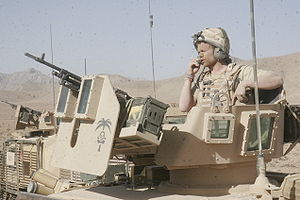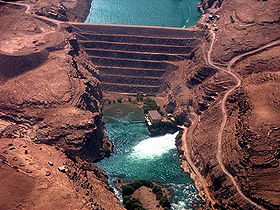- Operation Eagle's Summit
-
Operation Eagle's Summit Part of the War in Afghanistan (2001–present)
British troops of the Queen's Royal Lancers providing security for the convoy.Date August 27, 2008 – September 5, 2008 Location Kandahar and Helmand Provinces, Afghanistan Result Coalition victory. Belligerents Coalition:
 United Kingdom,
United Kingdom,
 Afghanistan,
Afghanistan,
 Canada,
Canada,
 United States,
United States,
 Denmark,
Denmark,
 Australia,
Australia,
 France,
France,
 Netherlands
Netherlands Taliban insurgents
Taliban insurgentsCommanders and leaders  Mark Carleton-Smith
Mark Carleton-Smith? Strength UK: 2,000
Other ISAF: 1,000
ANA: 1,000
Total: 5,000Unknown Casualties and losses Canada: 1 killed, 7 injured[1]
UK: 2 injured
ANA: 2 injured200 killed (NATO claim)[2] Lejay · Eagle Fury · Lashkar Gah · Mountain Thrust · Sangin · Mountain Fury · Now Zad · Achilles · Musa Qala I · Volcano · Kryptonite · Silver · Pickaxe-Handle · Hammer · Nasrat · Musa Qala II · Garmsir · Eagle's Summit · Red Dagger · Shahi Tandar · Diesel · Mar Lewe · Panther's Claw · Strike of the Sword · Dahaneh · Cobra's Anger · Moshtarak · Tor Shezada
Timeline
2001 · 2002 · 2003 · 2004 · 2005 · 2006 · 2007 · 2008 · 2009 · 2010 · 2011
Battles and operationsCrescent Wind · Rhino · Mazari Sharif · Kunduz · Herat · Kabul · Tawin Kowt · Shawali Kowt · Sayyd Alma Kalay · Qala-i-Jangi · Kandahar · Tora Bora
Lejay · Eagle Fury · Lashkar Gah · Mountain Thrust · Sangin · Mountain Fury · Now Zad · Achilles · Musa Qala I · Volcano · Kryptonite · Silver · Pickaxe-Handle · Hammer · Nasrat · Musa Qala II · Garmsir · Eagle's Summit · Red Dagger · Shahi Tandar · Diesel · Mar Lewe · Panther's Claw · Strike of the Sword · Dahaneh · Cobra's Anger · Moshtarak · Tor Shezada
Medusa · Avalanche · Kaika · Panjwaii · Falcon Summit · Hoover · Luger · Kamin · Shah Wali Kot · 1st Kandahar · Spin Boldak · Sarposa Prison · Arghandab · Wech Baghtu · 2nd Kandahar · Nadahan wedding bombing · Kandahar
1st Kabul · Hotel Serena · 1st Indian Embassy · Uzbin · Feb 2009 Kabul raid · 2nd Indian Embassy · Bakhtar guest house · NATO headquarters · Jan 2010 Kabul raid · Feb 2010 Kabul raid · May 2010 Kabul bombing · NATO convoy
Kunduz airstrike · Oqab · Chora · Firebase Anaconda · Shewan · Balamorghab · Derapet ·
Airstrikes
Hyderabad · Sayyd Alma Kalay · Gora Prai · Azizabad · Granai · Deh Bala · Sangin · UruzganInsurgent attacks
Bagram Air Base · Baghlan · Camp ChapmanOperation Eagle's Summit (Oqab Tsuka in Pashto) was a military operation conducted by ISAF and Afghan National Army troops, with the objective of transporting a 220-tonne turbine to the Kajaki dam in Helmand province through territory controlled by Taliban insurgents. Ending in success for the coalition, it involved mostly British troops, and was said to have been one of the largest logistical operations carried out by the British Army since World War II.[3] The operation took its name from the eagle pictured on the insignia of the 16th Air Assault Brigade.[4]
Contents
Restoring Kajaki dam
USAID began work on the Kajaki hydroelectric dam in 1953, in order to provide electricity and irrigation to the population of Helmand and Kandahar provinces. It was supposed to house three turbines, but only two were ever installed, and after years of civil war, only one one was still in service by 2001 [5] In 2004, the United States started work on restoring the dam's capacity and bringing its output to 53 megawatts. One turbine was repaired in 2005, but the restoration was hampered by the difficulty of delivering new turbines to Kajaki through Taliban-controlled territory, that required a large-scale military operation.
Alternate route
60 British officers worked for four months in preparing the operation.[2] They planned to avoid taking the most direct route, Highway 611, which crossed several Taliban strongholds, and that was littered with IEDs placed by the insurgents and land mines left over from the Soviet presence in Afghanistan. Instead they planned to take the convoy carrying the turbine through the desert, following an itinerary codenamed "route Harriet", that was mapped by the Pathfinder platoon weeks before the operation. The British tried to negotiate safe passage for the convoy, in some cases distributing cash sums to local elders, but these deals didn't work out.[6]
The Chinese-made turbine was delivered to Kandahar airport on the night of August 27, and was taken through the first part of the journey by Canadian troops, till it reached a meeting point in the desert, where it was taken over by British forces.[2] It was broken down into seven separate loads, each weighing some 30 tonnes, and carried on HET trucks.
The main convoy, composed of 100 vehicles stretching over four kilometres, included 50 Viking APCs, and Jackal and Mastiff vehicles. The whole Combat Logistic Patrol, as the convoys are called in military terminology, was made up of three elements. The Engineer Group (9 Parachute Squadron RE), the Command Group (CO 13 Air Assault Support Regiment RLC) and the Turbine Element (15 Air Assault Close Support Squadron RLC). Amongst the convoy were eight critical vehicles:
- Four Transformers
- Two Stators
- One Upper Bracket Assembly
- 80 Ton Crane
Attack helicopters provided overwatch, while air support came in the shape of US, French and Dutch aircraft. Combat Engineers provided support, by building and shoring up the road the convoy was due to travel on.[5]
Heliborne troops from the Parachute Regiment provided security for the convoy, by leapfrogging along its path.[3][7]
At the same time, a dummy convoy composed of 30 to 40 Danish vehicles advanced along Highway 611, escorted by the 1st battalion, the Parachute Regiment, in order to deceive the Taliban into ignoring "Harriet".[3]
During the last stretch of the route, the main convoy was obliged to rejoin Highway 611, and travel through 4.5 miles of territory where some 200 insurgents were known to be active. The task of clearing the area was given to a force composed of 388 ANA soldiers and their 42 mentors from a Royal Irish Regiment OMLT. After three days of intensive bombardment from NATO artillery, including MLRS rockets, and from coalition aircraft, the road was cleared of insurgents, allowing the convoy to reach its destination on September 3 at 2.30am.[4] It took five days to travel 180 km, during which the convoy had endured very few attacks, and suffered no casualties through Taliban action.[2] During this time British artillery fired 800 105mm shells and 54 rockets.[3] The British claimed to have killed some 200 insurgents, but this claim could not be independently verified.[2]
Casualties
One British soldier was injured in a Road Traffic Accident at Kajaki, and one Canadian soldier died and a further seven injured, when their vehicle struck an Improvised Explosive Device when returning to base.[1][8]
Outcome
The operation was hailed by NATO as a significant victory, that would contribute to winning the "hearts and minds" of the Afghan people. Brigadier Carleton-Smith, commander of Task Force Helmand, described it as "the end of the beginning" of the fighting in Helmand.[3] However, British engineers estimate that installing the turbines and building a suitable power distribution network will take another two years.[9]
References
- ^ a b "Kajaki dam troops return to base". MoD. 2008-09-09. http://www.mod.uk/DefenceInternet/DefenceNews/MilitaryOperations/KajakiDamTroopsReturnToBase.htm. Retrieved 2008-09-10.
- ^ a b c d e Leithead, Alastair (2008-09-03). "UK troops in huge turbine mission". BBC. http://news.bbc.co.uk/2/hi/uk_news/7593901.stm. Retrieved 2008-09-04.
- ^ a b c d e Page, Jeremy (2008-09-03). "Triumph for British forces in Boy's Own-style Kajaki mission". The Times. http://www.timesonline.co.uk/tol/news/world/asia/article4660274.ece. Retrieved 2008-09-04.
- ^ a b Judd, Terri (2008-09-03). "Operation Eagle's Summit: the inside story of a daring foray into Taliban territory". The Independent. http://www.independent.co.uk/news/world/asia/operation-eagles-summit-the-inside-story-of-a-daring-foray-into-taliban-territory-917197.html. Retrieved 2008-09-04.
- ^ a b Yon, Michael (Sept 2008). "Where Eagles Dare". http://www.michaelyon-online.com/index.php?option=com_content&view=article&id=1967:where-eagles-dare&catid=34:dispatches&Itemid=55. Retrieved 2008-09-07.
- ^ "Firefights cleared way for Afghan turbine convoy". ABC News (Australia). 2008-09-03. http://www.abc.net.au/news/stories/2008/09/03/2353781.htm. Retrieved 2008-09-04.
- ^ "British troops complete operation to deliver vital power turbine". MoD. 2008-09-02. http://www.mod.uk/DefenceInternet/DefenceNews/MilitaryOperations/BritishTroopsCompleteOperationToDeliverVitalPowerTurbine.htm. Retrieved 2008-09-04.
- ^ "Sergeant Prescott Shipway". Canadian Forces. http://www.army.forces.gc.ca/lf/English/6_1_1.asp?id=2935. Retrieved 2008-09-13.[dead link]
- ^ Baker, Luke (2008-09-03). "Kajaki George's Afghan turbine offers hope, hurdles". Reuters. http://www.alertnet.org/thenews/newsdesk/BAK343906.htm. Retrieved 2008-09-04.
Categories:- NATO operations in Afghanistan
- Military operations of the War in Afghanistan (2001–present) involving the United Kingdom
- Military operations of the War in Afghanistan (2001–present) involving Afghanistan
- Military operations of the War in Afghanistan (2001–present) involving the United States
- Military operations of the War in Afghanistan (2001–present) involving Australia
- Military operations of the War in Afghanistan (2001–present) involving Canada
- Military operations of the War in Afghanistan (2001–present) involving Denmark
- Battles of the War in Afghanistan (2001–present) involving France
- Military operations of the War in Afghanistan (2001–present) involving the Netherlands
- 2008 in Afghanistan
Wikimedia Foundation. 2010.
Look at other dictionaries:
Opération Eagle's Summit — Informations générales Date 27 août 5 septembre 2008 Lieu Provinces de Kandahar et d Helmand. Issue Victoire de la Coalition Belligérants Forces terrestres … Wikipédia en Français
Operation Eagle (disambiguation) — Operation Eagle may refer to: Operation Eagle (Sinai) (2011) Operation Eagle (Sri Lanka) (1990) Operation Eagle may also refer to: Operation Eagle Ares (2007) Operation Eagle Assist (2001) Operation Eagle Attack (1940) Operation Eagle Claw (1980) … Wikipedia
Operation Eagle Fury — v · … Wikipedia
Operation Eagle Guardian — Eagle Guardian is a NATO regional defence scheme drawn up in early 2010 to defend the Baltic states and Poland against an attack by Russia. The plan identifies ports in Poland and Germany to receive naval assault forces, as well as British and US … Wikipedia
Opération Falcon Summit — Informations générales Date du 15 décembre 2006 à janvier 2007 Lieu District de Panjwaye Issue Victoire de la Coalition Belligérants … Wikipédia en Français
Opération Mountain Fury — Informations générales Date du 16 septembre 2006 au 15 janvier 2007 Lieu Province de Paktika, de Khost, de Ghazny, de Paktia et de Lograr Issue Victoire de la Coalition Belligérants … Wikipédia en Français
Opération Médusa — Opération Medusa Informations générales Date du 2 au 17 septembre 2006 Lieu District de Panjwaye et de Zhari, province de Kandahar Issue Victoire de la Coalition Belligérants Forces terrestres … Wikipédia en Français
Opération Medusa — Informations générales Date du 2 au 17 septembre 2006 Lieu District de Panjwaye et de Zhari, province de Kandahar Issue Victoire de la Coalition Belligérants Forces terrestres … Wikipédia en Français
Opération Strike of the sword — (Khanjar) En rouge l opération Strike of the sword; en bleu l Opération Panther s Claw Informations générales Date Du 2 … Wikipédia en Français
Operation Anaconda — Opération Anaconda en Afghanistan Pour L opération militaire française homonyme, voir Opération Anaconda en Guyane. Opération Anaconda Informations générales Date du 1er au 18 mars 2002 Lieu Vallée de Shahi Kot dans la province de Paktia… … Wikipédia en Français


